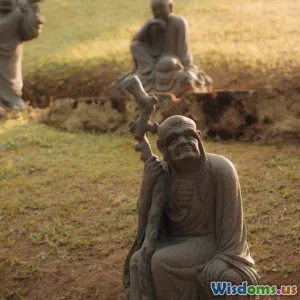
Modern Challenges in Translating Ancient Spiritual Manuscripts
7 min read Explore the complexities and modern dilemmas in translating ancient spiritual texts and how they impact our understanding of timeless wisdom. (0 Reviews)
Modern Challenges in Translating Ancient Spiritual Manuscripts
Ancient spiritual manuscripts hold the profound wisdom of civilizations long past—their philosophies, religions, rituals, and reflections on existence. These texts inspire millions but are often shrouded in linguistic, cultural, and contextual mysteries, making their translation a formidable task. In the contemporary world, where access to information is unprecedented, the practice of translating these manuscripts faces distinct modern challenges.
Introduction
Imagine unlocking a dusty scroll buried for centuries and awakening voices from bygone eras. Yet, the bridge between ancient text and contemporary reader is more than just language conversion; it involves decoding symbolism, intent, and tradition.
The stakes are high. Misinterpretations can erase or distort sacred values and knowledge. Translators are not mere linguistic technicians but custodians safeguarding humanity’s spiritual heritage. This article delves into the multifaceted obstacles modern translators encounter when working on ancient spiritual manuscripts.
Linguistic Ambiguities and the Death of Original Languages
The Loss of Nuance Through Time
Many ancient spiritual manuscripts were written in languages or dialects that have evolved or vanished entirely—Sanskrit, Classical Chinese, Coptic, and others. For instance, the Rigveda, one of the oldest Indian spiritual texts written in Vedic Sanskrit, contains words and hymns whose meanings are debated even today. Scholars grapple not only with vocabulary but also the syntax and grammar rooted in oral traditions.
Polysemy and Metaphor
Ancient languages often embrace metaphorical or polysemous (multiple meanings) words. A single Sanskrit term like “Dharma” encompasses law, duty, righteousness, and cosmic order. Choosing an English equivalent demands careful judgment, as each possible substitute shapes the reader’s understanding differently.
Example: The Bhagavad Gita
Translations of the Bhagavad Gita vary widely depending on the translator’s cultural or theological stance. For example, the term “Yoga” has been interpreted narrowly as physical postures or broadly as spiritual union. The choice significantly influences the philosophical takeaways for modern readers.
Cultural Context and Historical Distance
Beyond Words: Religious and Cultural Symbolism
Spiritual texts are deeply embedded in their socio-cultural environment. Without this context, translators risk misrepresenting divine concepts or practices. For instance, the symbolism of the lotus flower in Buddhist manuscripts is not merely botanical but represents purity and enlightenment.
Temporal Disconnect
An ancient text’s worldview, ethics, or cosmology may conflict with today’s perspectives. Translators must balance faithfulness to original thought with clarity for contemporary audiences without imposing modern biases.
Real-World Insight
Access to researchers across disciplines—historians, theologians, anthropologists—helps translators develop richer interpretations. Projects like the Mahayana Sutra Translation Initiative actively gather multidisciplinary expertise to contextualize Buddhist texts accurately.
Technological Challenges and Opportunities
Manuscript Condition and Accessibility
Many spiritual manuscripts survive only in fragile, damaged, or partial forms. Before translation, scholars often rely on high-resolution digitization or multispectral imaging to recover faded text. For example, the Dead Sea Scrolls’ revelations were enhanced via advanced imaging techniques enabling better scholarly translation.
Digital Tools in Translation
Modern computational linguistics offers assistance but also limitations. Machine translation tools struggle with the metaphoric depth and polysemy prevalent in spiritual manuscripts. However, AI-powered semantic analysis can suggest possible interpretations or highlight textual inconsistencies for human review.
Collaboration Platforms
Digital collaboration environments now allow global experts to work jointly on translations, blending perspectives and iterative feedback, mitigating isolated inaccuracies.
Philosophical and Ethical Concerns
Translator Bias and Interpretation
Each translator inevitably frames the ancient text through their worldview. This can lead to either secularizing sacred concepts or over-religionizing historical narratives, affecting authenticity.
Ethicist Harry Oldmeadow asserts, “The translator is not simply conveying words but providing a version of truth that carries immense responsibility.”
Secrecy and Restricted Texts
Certain spiritual manuscripts were intentionally esoteric or encoded to restrict access to enlightened individuals. Should modern translators disclose such knowledge openly? Balancing intellectual freedom with respect for spiritual traditions poses ethical dilemmas.
Case Study: The Nag Hammadi Library
Discovered in 1945 in Egypt, the Nag Hammadi codices contain Gnostic texts with profound spiritual teachings differing from orthodox Christianity. Translators faced challenges decrypting Gnostic jargon, rendering concepts foreign to contemporary theological frameworks, and presenting doctrines marginalized historically.
Their translation required not only linguistic skill but innovative hermeneutic approaches and open academic discourse. The endeavor profoundly reshaped modern understanding of early Christian spiritual diversity.
Conclusion
Translating ancient spiritual manuscripts today is a complex interplay of linguistic mastery, cultural empathy, technological innovation, and ethical sensitivity. It demands translators to be not just bilingual but bicultural mediators, historians, interpreters, and stewards of sacred knowledge.
Successful translation can unlock transcendent wisdom spanning millennia, offering valuable philosophies for modern living. Yet, the challenges remind us that every translation is also a new creation, shaped by its time and the hands that craft it.
As readers and seekers, recognizing these challenges can inspire humility, spark curiosity, and encourage continued support for efforts to preserve and understand our profound spiritual heritage.
References
- Flood, Gavin. The Importance of Sacred Literature: A Study of Ancient Texts. Oxford University Press, 2014.
- McEvilley, Thomas. The Shape of Ancient Thought. Allworth Press, 2002.
- Smith, Huston. The World's Religions. HarperOne, 1991.
- Lohfink, Gerhard. "Ancient Languages in Modern World: Challenges of Translation." Journal of Theological Studies, 2018.
Rate the Post
User Reviews
Other posts in Sacred Texts & Wisdom
Popular Posts


















